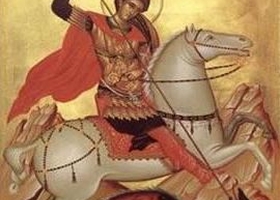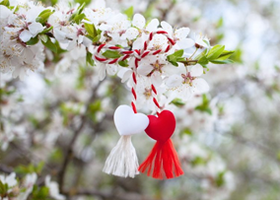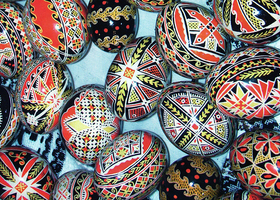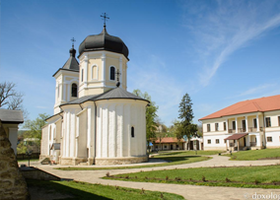Easter
The feast of Easter is the greatest, most meaningful, holiest and most joyful holiday of the year. It is the day on which "Christ rose from the dead", a day awaited with great longing and joy by Romanians everywhere and which always falls at the beginning of spring, the season when all nature comes to life. Numerous events take place not only on Easter Day, but also on the days preceding and following it.
The Great Lent (Easter Lent), which lasts for 40 days, plus Holy Week or Passion Week, is a period marked by culinary prohibitions and devoid of parties and entertainment. It is a time when the world spends a period of time in mediation and atonement for sins, so that people can purify themselves in the run-up to the great miracle of mankind - the Resurrection of Jesus Christ. It begins with Clean Monday and includes many specific Christian celebrations and rituals, as well as pre-Christian ones.
On Clean Monday, the first day of Lent, the domestic and surrounding world is purified by washing dishes, eating purifying foods, etc. On the feast of the 40 Holy Martyrs, known as the Agrarian New Year, the main ceremonial moment is when the plough is brought out for ploughing. Nowadays, village farmers join together on the basis of kinship, neighbourliness or mutual sympathy for spring agricultural work (ploughing and sowing), the agreement ending with a small party, at which it is customary for each farmer to drink 40 glasses of wine or brandy. Women still bake small martyr pretzels similar in appearance to prehistoric fertility idols. Made of leavened dough in the shape of a figure eight, the little pretzels are baked in the oven, spread with honey, sprinkled with walnut kernels and given as alms or thrown in the orchards for a rich harvest. Weather forecasts are also made on this day, and all magical practices, all charms begin on the day of the martyrs.
The Annunciation, also called Blagoveștenie, is celebrated on the day when the Orthodox Christian Church celebrates the good news that the Archangel Gabriel brought to the Blessed Virgin Mary that she will give birth to Jesus Christ, the Saviour of the world. The Annunciation is celebrated with the greatest sanctity, being, according to faith, a celebration just as great as the Resurrection or Easter.
The sin of the one who works during this day is very great, and the one who seeks trouble on this day will fare very badly. It is also said that as the time will be on the day of Annunciation, so will it be on the day of Easter. Blagoveștenia is also known as the Day of the Cuckoo, in folk spiritual tradition the cuckoo being the most loved, revered and sung bird. After its arrival on Annunciation, the cuckoo became a living landmark, according to which the householder predicted the change of weather and had forecast the human lifespan. If you heard the first song of the cuckoo on an empty stomach or pocket, it was a bad sign, of trouble, illness or even death, which is why people were careful that on this day they were fed and had money in the pocket, and if they heard the cuckoo singing they threw coins in its direction.
The day of Jesus Christ's entry into Jerusalem, when the Saviour was greeted with branches of dates and other flowers, is known as Floriile or Palm Sunday. It is the day that is dedicated to the cultural and religious value of the willow tree, but it is also the day that signifies the return of spring, as from this day all the trees and flowers begin to bud and blossom. On this Sunday, the green branches of the willow tree, harvested the day before, are taken to the church to be consecrated and then distributed to the faithful. On this occasion, the branches acquire special virtues: protection of the household and animals from evil spirits, prediction of human lifespan (the number of buds on the branch shows the owner how long he will live), fertilisation, prevention and treatment of diseases.
The period preceding the feast of the Resurrection is Holy Week or Passion Week, a characteristic, ritual period marked by two special moments: Maundy Thursday and Good Friday.
On Maundy Thursday (Passion Thursday), according to popular belief, the tombs, skies and the gates of heaven are opened, a time when the cult of the dead is manifested. Women hand out cakes, pies, clay or ceramic pots filled with water, wine or food and accompanied by lighted candles to remember the dead. In some villages, the custom of lighting fires is still maintained, so that the spirits of the dead can come among the living, to the houses where they lived and spend Easter together.
The last Friday of the Great Lent is known by many names: Good Friday, because it belongs to the Paschal cycle of the Great Week; Good Friday, because it is the day of fasting: Good Friday, because Jesus suffered and was crucified on a Friday: Good Friday, because it precedes the great feast of the Lord's Resurrection, Easter. On this day, the Air (the cloth depicting the burial of Jesus Christ), which symbolises the inanimate body of the Saviour, is taken from the altar and placed in the middle of the church for the vigil, where it remains until the resurrection.
A series of household chores are carried out during Passion Week: the men clean the household, mend fences, plough the garden, chop wood, while the women do housework, paint, wash the whites, colour and paint eggs, prepare ritual food (pasca, babas, various baked cakes, pies, Easter lamb). It is the period when, dominated by holy duties, but also fearful of the constraint of tradition, of the word of the villagers, householders enter into a kind of competition with each other, aiming to be on par with the community.
Made on Maundy Thursday or Great Saturday (Easter Saturday), pasca is the most significant bakery item (like matzo), without which no one in Moldova would believe Passover has arrived. It is made of wheat flour, in a round shape (in memory of the cloth that Jesus was wrapped in) or in a square shape (because also the tomb where the Savior was buried was square).
The pasca is embellished at the edges with braids, and in the middle with a braided or simple cross, symbolising the cross on which the Savior of the world was crucified. There are also simple pascas, without braids and without a cross in the middle, only with fringes around the edges.
Between the braids or between the serrations is usually placed cottage cheese, rarely sheep's cheese, salted and kneaded with egg yolk, sugar, cinnamon and garnished with raisins. The cross-shaped pastries are taken to the church on Easter day to be consecrated; the simple ones are intended for family members, while the small ones are made especially for children's enjoyment or to be given to the poor who stand at the door or gate of the church. Next to the pasca, which occupies a privileged place in the ceremonial of the Resurrection service, women also bake other goods, such as: cakes, pies, bаbas, braided stuffed dough, etc.
Pasca is made not only at Easter, but also on St. George's Day, Ascension or Ispas and on Great Sunday or Palm Sunday. After the Great Sunday until the next Easter, pasca is no longer made.
Traditional symbols of deep meaning, red eggs, specially boiled, coloured and painted on the occasion of the great feast of the Resurrection, represent a spiritual revolution, a regeneration for the good of mankind. Many legends in Romanian spirituality have the Resurrection as the starting point for the reddening of eggs. It is said that the stones thrown at Jesus when he came out of the temple turned into red eggs or that the legend of the reddening of the eggs appeared to remind us of the torments endured by the Saviour, the blood shed during the crucifixion. According to another legend, the Mother of God went with a basket of eggs to the guardians of the crucified Jesus for mercy, but when they refused to talk to her, she placed the basket of eggs at her son's feet and the blood flowing from Jesus' body turned the eggs red, at which point the Saviour said, "From now on, paint the eggs red".
In Moldova, eggs are reddened on Maundy Thursday, Good Friday and Easter Saturday. Not only red eggs are used at Easter, but also eggs of various other colours: yellow, green, blue. Because in the beginning only red eggs were made, Romanians make and wait for Easter more with these eggs and it is also because of this tradition that mostly red eggs are used. Besides these kinds of eggs, called in some parts of Moldova "little apples", because they have only оne single colour, women also make, since the Annunciation, two kinds of eggs: coloured and painted, the difference between them consisting in the technique of ornamentation.
Work on the boiled eggs is always done while warm to allow the ink to dry quickly and use a brush and pencil tip. The basic element of painting the eggs (also known as "suffered eggs" because they require a lot of patience, care and skill) is wax, which is applied to the surface of the egg, followed by successive colour bathing. They are worked with a thin pork-hair brush and ornamented cold, only the colour bath is warm, and when they are ready ornamented, they are placed near a heat source for melting the wax.
Egg colouring and painting are crafts which, through the skilful combination of traditional motifs and the blending of colours, but also as a result of cross-cultural influences, have become a true art.
Ancient, 'old' motifs taken from folk legends ('the lost path') or from everyday life ('the horns of the plough', 'the tassel', 'the wheat stalk') alternate with solar motifs ('the rosette') or religious motifs ('the cross'). The differentiation between the localities where the craft of egg colouring or painting is practised is made by the colour palette. Traditionally, natural colours were used, obtained from plants or parts of plants (leaves, flowers, bark, roots). Today, attempts are again being made to obtain natural colours, but the vast majority of designers use commercial chemical dyes.
On Saturday evening, as day begins to fade into night, all preparations for the Easter feast are completed, so all handwork ceases.
The feast of Easter, and especially the Resurrection, the greatest of all holidays of the year, is welcomed everywhere with great joy, being a manifestation of divinity in the world, when the bond between man and God is stronger than ever. Man spends the feast with a clean soul and body, with harmony, grandeur and a deep sense of love for his fellows.
Years ago, those who went to the Resurrection service, and all the members of the family, when they woke up in the morning on the first day of Easter, washed their faces in a large bowl, in which was fresh, clean water, one or more red eggs, and a few gold or silver coins. By this ceremony, the man made sure that he would be light and healthy as the egg, that his face would be as flushed as the red colour of the egg over the year, that he would be clean as the silver and the gold, and that they would have a lucky year. Today, the custom is still practiced, especially in the morning, on the first day of Easter, when people replace gold or silver coins with coins and add one or more sprigs of basil to the pot. They symbolically wash their faces and cross their foreheads with slightly reddened water from the dyed egg in the hope that they will be healthy, strong and beautiful throughout the year as the red egg.
All those who attend the Resurrection Mass must bring a candle with them, which they light and keep lit during the whole Mass. They also bring with them Easter baskets ("woven of wicker and covered with white cloth, trimmed with stitching"), filled with food or household items, to be consecrated: pastry, eggs, butter, cake, salt, cheese, sugar, roast meat, sausages, smoked meats, basil, a candle. Easter products are eaten at the festive Easter meal or, some of them, are still kept in the house to be used throughout the year in folk medicine or in charms to speed up marriages or in case of a storm with thunderbolts.
There is a custom that, from the moment the priest first utters the words "Christ is risen" at the Resurrection service, from then until Ispas or Ascension Day Romanians everywhere greet each other when they meet only with "Christ is risen!" and "Truly He is Risen!".
Then follows the ceremonial washing on the first day of Easter, followed by the traditional Easter meal with Easter products, attended only by family members, since on the first day of Easter there are no visits, the celebration being a family event. Eggs are first knocked by the spouses, then by the children with their parents, and it is customary for the family member who is left with the whole egg to receive all the eggs that have been cracked.
Linkuri utile
https://ro.wikipedia.org/wiki/Pa%C8%99ti
https://www.crestinortodox.ro/datini-obiceiuri-superstitii/istoria-sarbatorii-pastelui-68755.html
http://curentul.md/stiri/traditii-si-obiceiuri-de-pasti-cum-petrec-moldovenii-aceasta-sarbatoare.html
https://moldova1.md/p/8011/sarbatoarea-pastelui-in-lume-traditii-si-obiceiuri


 ro
ro
 ru
ru




